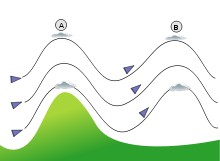

In meteorology, lee waves are atmospheric stationary waves. The most common form is mountain waves, which are atmospheric internal gravity waves. These were discovered in 1933 by two German glider pilots, Hans Deutschmann and Wolf Hirth, above the Giant Mountains.[1][2][3] They are periodic changes of atmospheric pressure, temperature and orthometric height in a current of air caused by vertical displacement, for example orographic lift when the wind blows over a mountain or mountain range. They can also be caused by the surface wind blowing over an escarpment or plateau,[4] or even by upper winds deflected over a thermal updraft or cloud street.
The vertical motion forces periodic changes in speed and direction of the air within this air current. They always occur in groups on the lee side of the terrain that triggers them. Sometimes, mountain waves can help to enhance precipitation amounts downwind of mountain ranges.[5] Usually a turbulent vortex, with its axis of rotation parallel to the mountain range, is generated around the first trough; this is called a rotor. The strongest lee waves are produced when the lapse rate shows a stable layer above the obstruction, with an unstable layer above and below.[4]
Strong winds (with wind gusts over 100 miles per hour (160 km/h)) can be created in the foothills of large mountain ranges by mountain waves.[6][7][8][9] These strong winds can contribute to unexpected wildfire growth and spread (including the 2016 Great Smoky Mountains wildfires when sparks from a wildfire in the Smoky Mountains were blown into the Gatlinburg and Pigeon Forge areas).[10]
- ^ On 10 March 1933, German glider pilot Hans Deutschmann (1911–1942) was flying over the Giant Mountains in Silesia when an updraft lifted his plane by a kilometre. The event was observed, and correctly interpreted, by German engineer and glider pilot Wolf Hirth (1900–1959), who wrote about it in: Wolf Hirth, Die hohe Schule des Segelfluges [The advanced school of glider flight] (Berlin, Germany: Klasing & Co., 1933). The phenomenon was subsequently studied by German glider pilot and atmospheric physicist Joachim P. Küttner (1909 -2011) in: Küttner, J. (1938) "Moazagotl und Föhnwelle" (Lenticular clouds and foehn waves), Beiträge zur Physik der Atmosphäre, 25, 79–114, and Kuettner, J. (1959) "The rotor flow in the lee of mountains." GRD [Geophysics Research Directorate] Research Notes No. 6, AFCRC[Air Force Cambridge Research Center]-TN-58-626, ASTIA [Armed Services Technical Information Agency] Document No. AD-208862.
- ^ Tokgozlu, A; Rasulov, M.; Aslan, Z. (January 2005). "Modeling and Classification of Mountain Waves". Technical Soaring. Vol. 29, no. 1. p. 22. ISSN 0744-8996.
- ^ "Article about wave lift". Retrieved 2006-09-28.
- ^ a b Pagen, Dennis (1992). Understanding the Sky. City: Sport Aviation Pubns. pp. 169–175. ISBN 978-0-936310-10-7.
This is the ideal case, for an unstable layer below and above the stable layer create what can be described as a springboard for the stable layer to bounce on once the mountain begins the oscillation.
- ^ David M. Gaffin; Stephen S. Parker; Paul D. Kirkwood (2003). "An Unexpectedly Heavy and Complex Snowfall Event across the Southern Appalachian Region". Weather and Forecasting. 18 (2): 224–235. Bibcode:2003WtFor..18..224G. doi:10.1175/1520-0434(2003)018<0224:AUHACS>2.0.CO;2.
- ^ David M. Gaffin (2009). "On High Winds and Foehn Warming Associated with Mountain-Wave Events in the Western Foothills of the Southern Appalachian Mountains". Weather and Forecasting. 24 (1): 53–75. Bibcode:2009WtFor..24...53G. doi:10.1175/2008WAF2007096.1.
- ^ M. N. Raphael (2003). "The Santa Ana winds of California". Earth Interactions. 7 (8): 1. Bibcode:2003EaInt...7h...1R. doi:10.1175/1087-3562(2003)007<0001:TSAWOC>2.0.CO;2.
- ^ Warren Blier (1998). "The Sundowner Winds of Santa Barbara, California". Weather and Forecasting. 13 (3): 702–716. Bibcode:1978JAtS...35...59L. doi:10.1175/1520-0434(1998)013<0702:TSWOSB>2.0.CO;2.
- ^ D. K. Lilly (1978). "A Severe Downslope Windstorm and Aircraft Turbulence Event Induced by a Mountain Wave". Journal of the Atmospheric Sciences. 35 (1): 59–77. Bibcode:1978JAtS...35...59L. doi:10.1175/1520-0469(1978)035<0059:ASDWAA>2.0.CO;2.
- ^ Ryan Shadbolt; Joseph Charney; Hannah Fromm (2019). "A mesoscale simulation of a mountain wave wind event associated with the Chimney Tops 2 fire (2016)" (Special Symposium on Mesoscale Meteorological Extremes: Understanding, Prediction, and Projection). American Meteorological Society: 5 pp.
{{cite journal}}: Cite journal requires|journal=(help)